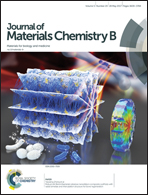Photothermal triggered protein release from an injectable polycaprolactone-based microspherical depot†
Abstract
Upon exposure to visible light, controlled multiple dose protein release was demonstrated by using a microspherical depot composed of biodegradable poly(ε-caprolactone) (PCL), bovine serum albumin (BSA) or horseradish peroxidase (HRP) as model protein, polymer-coated gold nanoparticles as photothermal component, which can potentially reduce the number of invasive therapeutic injections.



 Please wait while we load your content...
Please wait while we load your content...